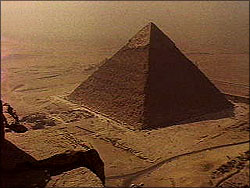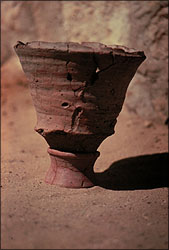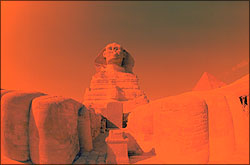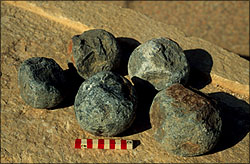
|
MARK LEHNER, Archaeologist, Oriental Institute of the University of Chicago, and Harvard Semitic Museum
NOVA: How do we know how old the pyramids are?
 LEHNER: It's not a direct approach. There are people coming from a New Age
perspective who want the pyramids to be very old, much older than Egyptologists
are willing to agree. There are people who want them to be built by
extraterrestrials, or inspired by extraterrestrials, or built by a lost
civilization whose records are otherwise unknown to us. And similar ideas are
said about the Sphinx. And in response to the evidence that we have for the
time in which the pyramids are built, the criticism is often leveled at
scholars that they're only dealing with circumstantial information. It's all
just circumstantial. And sometimes we smile at that, because virtually all
information in archaeology is circumstantial. LEHNER: It's not a direct approach. There are people coming from a New Age
perspective who want the pyramids to be very old, much older than Egyptologists
are willing to agree. There are people who want them to be built by
extraterrestrials, or inspired by extraterrestrials, or built by a lost
civilization whose records are otherwise unknown to us. And similar ideas are
said about the Sphinx. And in response to the evidence that we have for the
time in which the pyramids are built, the criticism is often leveled at
scholars that they're only dealing with circumstantial information. It's all
just circumstantial. And sometimes we smile at that, because virtually all
information in archaeology is circumstantial.
Rarely do we have people from thousands of years ago who are writing, who are
signing confessions. So there's no one easy way that we know what the date of
the pyramids happens to be. It's mostly by context. The pyramids are
surrounded by cemeteries of other tombs. In these tombs we find bodies.
Sometimes we find organic materials, like fragments of reed, and wood, wooden
coffins. We find the bones of the people who lived and were buried in these
tombs. All that can be radiocarbon dated, for example. But primarily we date
the pyramids by their position in the development of Egyptian architecture and
material culture over the broad sweep of 3,000 years. So we're not dealing
with any one foothold of factual knowledge at Giza itself. We're dealing with
basically the entirety of Egyptology and Egyptian archaeology.
NOVA: Can you give us an example of a single aspect of material culture, from
ancient Egypt that you might use as a starting point for dating the pyramids?
 LEHNER: The pottery, for example. All the pottery you find at Giza looks like
the pottery of the time of Khufu, Khafre, and Menkaure, the kings who built
these pyramids in what we call the Fourth Dynasty, the Old Kingdom. We study
the pottery and how it changes over the broad sweep, some 3,000 years. There
are people who are experts in all these different periods of pottery or
Egyptian ceramics. LEHNER: The pottery, for example. All the pottery you find at Giza looks like
the pottery of the time of Khufu, Khafre, and Menkaure, the kings who built
these pyramids in what we call the Fourth Dynasty, the Old Kingdom. We study
the pottery and how it changes over the broad sweep, some 3,000 years. There
are people who are experts in all these different periods of pottery or
Egyptian ceramics.
So to bring it down to a level that almost anybody can understand, if, for
example, you were digging around the base of the Empire State Building,
assuming that it was a ruin and the streets around it in Manhattan were filled
with dirt, and you started finding ceramics that were characteristic of the
Elizabethan era or say the Colonial period here in the United States, that
would be one thing. But if you started finding the Styrofoam cups and the
plastic utensils of the nearby delicatessen, then you would know by virtue of
their position in the overall material culture of the 20th century that that's
probably a good date for the Empire State Building. Of course then you'd look
at the Empire State Building's style and you'd compare it to the Chrysler
Building, and you'd compare it to the Citicorp Building, which is considerably
different. And you'd work out the different styles in the evolution of
Manhattan itself. But by and large, you would, in the broad scope, be able to
put the Empire State Building and Manhattan in an overall context of
development here in the United States and in the modern 19th and 20th
centuries. And you would know that it didn't date, for example, to the
colonial period of George Washington and Thomas Jefferson, because nothing
you'd find in the Empire State Building ruins, around it, in the dirt
surrounding it—maybe it's a stump sticking up above the sloping ruins of
Manhattan—nothing really looks like the flowing blue china, or the other
kinds of utensils and material culture that they used in the time of the
American Revolution. So it's hard to give a succinct answer to that question,
because we date things in archaeology on the basis of its context and a broad
mass of information and material culture—things that were used by people,
styles, and so on.
NOVA: When it comes to carbon dating, do you need organic material?
LEHNER: Right. There has been radiocarbon dating, or carbon-14 dating done
in Egypt obviously before we did our studies, and it's been done on some
material from Giza. For example, the great boat that was found just south of
the Great Pyramid, which we think belongs to Khufu, that was radiocarbon dated—coming out about 2,600 B.C.
NOVA: But how do you carbon date the pyramids themselves when they're made out
of stone, an inorganic material?
LEHNER: We had the idea some years back to radiocarbon date the pyramids
directly. And as you say, you need organic material in order to do carbon-14
dating, because all living creatures, every living thing takes in carbon-14
during its lifetime, and stops taking in carbon-14 when it dies. And then the
carbon-14 starts breaking down at a regular rate. So in effect, you're
counting the carbon-14 in an organic specimen. And by virtue of the rate of
disintegration of carbon-14 atoms and the amount of carbon-14 in a sample, you
can know how old it is. So how do you date the pyramids, because they're made
out of stone and mortar? Well, in the 1980s when I was crawling around on the
pyramids, as I used to like to do and still do, I noticed that contrary to what
many guides tell people, even the stones of the Great Pyramid of Khufu are put
together with great quantities of mortar. We're looking, you see, at the core.
A pyramid is basically, most basically, two separate constructions: it's an
outer shell of very fine polished limestone with great accuracy in its joints,
but most of that's missing; and the other construction is the inner core, which
filled in this shell. Since most of the outer casing is missing what you see
now is the step-like structure of the core. The core was made with a
substantial slop factor, as my friend who is a mechanic likes to say about
certain automobiles. That is, they didn't join the stones very accurately.
You have great spaces between the stones. And you can actually see where the
men were up there and they didn't, you know, they may have like four or five,
even six inches between two stones. And so they'd jam down pebbles and cobbles
and some broken stones, and slop big quantities of gypsum mortar in there. I
noticed that in the interstices between the stones and in this mortar was
embedded organic material, like charcoal, probably from the fire that they used
to heat the gypsum in order to make the mortar. You have to heat raw gypsum in
order to dehydrate it, and then you rehydrate it in order to make the mortar,
like with modern cement.
So it occurred to me that if we could take these small samples, we could radiocarbon
date them, not with conventional radiocarbon dating so much, but
recently there's been a development in carbon-14 dating where they use atomic
accelerators to count the disintegration rate of the carbon-14 atoms, atom by
atom. So you can date extraordinarily small samples. So we set up a program
to do that. And it involved us climbing all over the Old Kingdom pyramids,
including the ones at Giza, taking as much in the way of organic samples as we
could. We weren't damaging the pyramids, because these are tiny little flecks
and it's a very strange experience to be crawling over a monument as big as
Khufu's, looking for a bit of charcoal that might be as big as the fingernail
on your small finger. We noted, not only the samples of charcoal, sometimes
there was reed. Now and then in some of the pyramids we found little bits of
wood. But we saw in many places, even on the giant pyramids of Giza, the first
pyramid and the second pyramid and the third one, fragments of tools, bits of
pottery that are clearly characteristic of the Old Kingdom. And it occurred to
us, you know, these are not just objects, these, the pyramids themselves were
archaeological sites during the time they were being built. If it took 20
years to build them—and now we begin to think that Khufu may have reigned
double the length of time that we traditionally assign him—if people were
building the Great Pyramid over three decades, it was an occupied site as long
as some camp sites that hunters and gatherers occupied that archaeologists dig
out in the desert.
So you see the pyramids are very human monuments. And the evidence of the
people who built them, their material culture is embedded right into the very
fabric of the pyramids. And I think I could take just about any interested
person and show them this kind of material embedded in the pyramids as well as
tool marks in the stones and say, hey, folks, these weren't lasers. These were
chisels and hammers and you know, people who were really out there.
NOVA: What does the radiocarbon dating tell us about the date of the
pyramids?
LEHNER: Well, we did a first run in 1984, actually, funded by the Edgar Cayce
Foundation because they had definite ideas that the pyramids were much older
than Egyptologists believed. That they date as early as 10,500 B.C. Well,
obviously for them it was a good test case because radio carbon dating does not
give you pinpoint accuracy. If you have a plus or minus factor, but I say it's
kind of like shooting at a fly on a barn with a shotgun. Well, you're not
going to hit the fly exactly, you're going to know which side of the barn,
which end of the barn, you know, the buckshot is scattering. And it wasn't
scattering at 10,500 B.C. on that first run of some 70 samples from a whole
selection of pyramids of the Old Kingdom. But it was significantly older than
Egyptologists believed. We were getting dates from the 1984 study that were on
the average 374 years too old for the Cambridge Ancient History, (the Cambridge
Ancient History is a reference) dates for the kings who built these monuments.
So just recently we took some 300 samples, and in collaboration with our
Egyptian colleagues, we are now in the process of dating these samples. The
outcome we are going to announce jointly in tandem with our Egyptian
colleagues, and maybe we can pick up the subject of the results when we're over
there in Egypt together with Dr. Zahi Hawass (during the February excavation of
the bakeries at Giza).
NOVA: Is there any evidence at all that an ancient civilization predating the
civilization of Khufu, Khafre and Menkaure was there?
LEHNER: It's a good question. If they were there, you see—civilizations
don't disappear without a trace. If archaeologists can go out and dig up a
campsite of hunters and gatherers that was occupied 15,000 years ago, there's
no way there could have been a complex civilization at a place like Giza or
anywhere in the Nile Valley and they didn't leave a trace, because people eat,
people poop, people leave their garbage around, and they leave their traces,
they leave the traces of humanity.
 Now at Giza, I should tell people how this has come down to me personally.
Because I actually went over there with my own notions of lost civilizations,
older civilizations from Edgar Cayce. When I worked at the Sphinx over a five-year
period we were mapping every nook and cranny, every block and stone, and
actually every fissure and crack as well. And I, on a couple of different
occasions was able to excavate natural solution cavities in the limestone from
which the Sphinx is made. Natural solution cavities are like holes in Swiss
cheese. When the limestone formed from sea sediments 50 million years ago
there were bubbles and holes and so on, and fissures later developed from
tectonic forces cracking the limestone. So for example, right at the hind paw
of the Great Sphinx on the north side, this main fissure that cuts through the
whole body of the Sphinx and then through the floor opens up to about 30
centimeters wide and about a meter or more in length. And in tandem with Zahi
Hawass in 1979-'80, we were clearing out this fissure, which now is totally
filled with debris again. But we actually reached down to our armpits, lying
on our sides on the floor, scooping out this clay. And in the clay was
embedded, not only charcoal, but bits of pottery that were very characteristic
of the pottery that was used during the time of Khufu, Khafre and Menkaure, the
4th Dynasty. Now at Giza, I should tell people how this has come down to me personally.
Because I actually went over there with my own notions of lost civilizations,
older civilizations from Edgar Cayce. When I worked at the Sphinx over a five-year
period we were mapping every nook and cranny, every block and stone, and
actually every fissure and crack as well. And I, on a couple of different
occasions was able to excavate natural solution cavities in the limestone from
which the Sphinx is made. Natural solution cavities are like holes in Swiss
cheese. When the limestone formed from sea sediments 50 million years ago
there were bubbles and holes and so on, and fissures later developed from
tectonic forces cracking the limestone. So for example, right at the hind paw
of the Great Sphinx on the north side, this main fissure that cuts through the
whole body of the Sphinx and then through the floor opens up to about 30
centimeters wide and about a meter or more in length. And in tandem with Zahi
Hawass in 1979-'80, we were clearing out this fissure, which now is totally
filled with debris again. But we actually reached down to our armpits, lying
on our sides on the floor, scooping out this clay. And in the clay was
embedded, not only charcoal, but bits of pottery that were very characteristic
of the pottery that was used during the time of Khufu, Khafre and Menkaure, the
4th Dynasty.
 We did that again on the floor of the Sphinx temple which is built on a lower
terrace directly below the paws of the Sphinx. Directly in front of the
Sphinx, we found a solution cavity in 1978, during what's called the SRI
Project, which has been written about. We actually cleared out this cavity.
We found dolomite pounders, these round balls of hard dolomite that are
characteristic hammerstones of the age of the pyramids that they used for
roughing out work in stone. Beyond that, Zahi and I excavated deposits on the
floor of the Sphinx, even more substantial, deposits that were sealed by an
18th Dynasty temple, built by Tutankamen's great grandfather when the Sphinx
was already 1,200 years old. But it was built by a pharaoh named Amenhotep II
and his son, Thelmos IV. They put the foundation of this temple right over
deposits of the Old Kingdom, and sealed it, so that they were left there and
were not cleared away by earlier excavators in our era in the 1930s. We did that again on the floor of the Sphinx temple which is built on a lower
terrace directly below the paws of the Sphinx. Directly in front of the
Sphinx, we found a solution cavity in 1978, during what's called the SRI
Project, which has been written about. We actually cleared out this cavity.
We found dolomite pounders, these round balls of hard dolomite that are
characteristic hammerstones of the age of the pyramids that they used for
roughing out work in stone. Beyond that, Zahi and I excavated deposits on the
floor of the Sphinx, even more substantial, deposits that were sealed by an
18th Dynasty temple, built by Tutankamen's great grandfather when the Sphinx
was already 1,200 years old. But it was built by a pharaoh named Amenhotep II
and his son, Thelmos IV. They put the foundation of this temple right over
deposits of the Old Kingdom, and sealed it, so that they were left there and
were not cleared away by earlier excavators in our era in the 1930s.
Zahi and I sort of did a stratographic dissection of these ancient deposits.
That is we did very careful trenches, recorded the layers and the different
kinds of material. The bottom material sealed by a temple built by
Tutankamen's great or great great grandfather, was Old Kingdom construction
debris. They stopped work cutting the outlines of the Sphinx ditch—the
Sphinx sits down in this ditch or sanctuary. We were able to show exactly
where they stopped work. They didn't quite finish that. We found tools, we
found pottery, characteristic of the Old Kingdom time of Khufu, Khafre, and
Menkaure.
Now the point is this. That it's not just this crevice or that nook and cranny
or that deposit underneath this temple, but all over Giza, you find this kind
of material. And as I say in looking for our carbon-14 samples, climbing in
the pyramids you find the same material embedded in the very fabric of the
pyramids, in the mortar bonding the stones together. So back to the question,
is there an earlier civilization? Well, as I say to New Age critics, show me
one pot shard of that earlier civilization. Because the only way they could
have existed is if they actually got out with whisk brooms, scoop shovels and
little spoons and cleared out every single trace of their daily lives, their
utensils, their pottery, their wood, their tools and so on, and that's just
totally improbable. Well, it's not impossible, but it has a very, very low
level of probability, that there was an older civilization there.
Photos: (1,4,5) Aaron Strong; (2) From "This Old Pyramid"; (3) Carl Andrews
Pyramids Home | Pyramids | Excavation
Contents | Mail
|